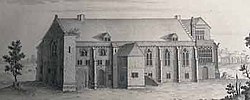Bradenstoke Abbey

18th-century engraving of the Priory by Samuel and Nathaniel Buck
|
|
| Monastery information | |
|---|---|
| Order | Augustinian |
| Established | 1142 |
| Disestablished | 1539 |
| Dedicated to | St. Mary |
| People | |
| Founder(s) | Walter FitzEdward de Salisbury |
| Site | |
| Location | Bradenstoke, Wiltshire, England |
| Coordinates | 51°30′44″N 2°00′13″W / 51.51222°N 2.00361°W |
| Visible remains | Tower and undercroft |
| Public access | Yes |
Bradenstoke Priory is a medieval priory in the village of Bradenstoke, Wiltshire, England. It is noted today for some of its structures having been used by William Randolph Hearst for the renovation of St Donat's Castle, near Llantwit Major, Wales, in the 1930s.
The priory was founded in 1142 as the Augustinian priory of Clack, and dedicated to Saint Mary. It was well-sited on a high ridge near a holy well, with further springs nearby; there is some evidence that a chapel of the era of Henry I already existed at the holy well.
The founder, Walter FitzEdward de Salisbury, was the son of Edward de Salisbury, a High Sheriff of Wiltshire; he gave lands for a priory as a daughter house of St. Mary's Abbey, Cirencester, according to its charter, "to serve God forever!". After the death of his wife, he "took the tonsure and habit of the canons" and on his death in 1147, was buried in the Priory, near the choir. His descendants, the Earls of Salisbury remained closely connected with the priory for many years. In 1190 thirteen of the monks migrated to Cartmel Priory, Cumbria, which had been recently established by William Marshal.
...
Wikipedia
